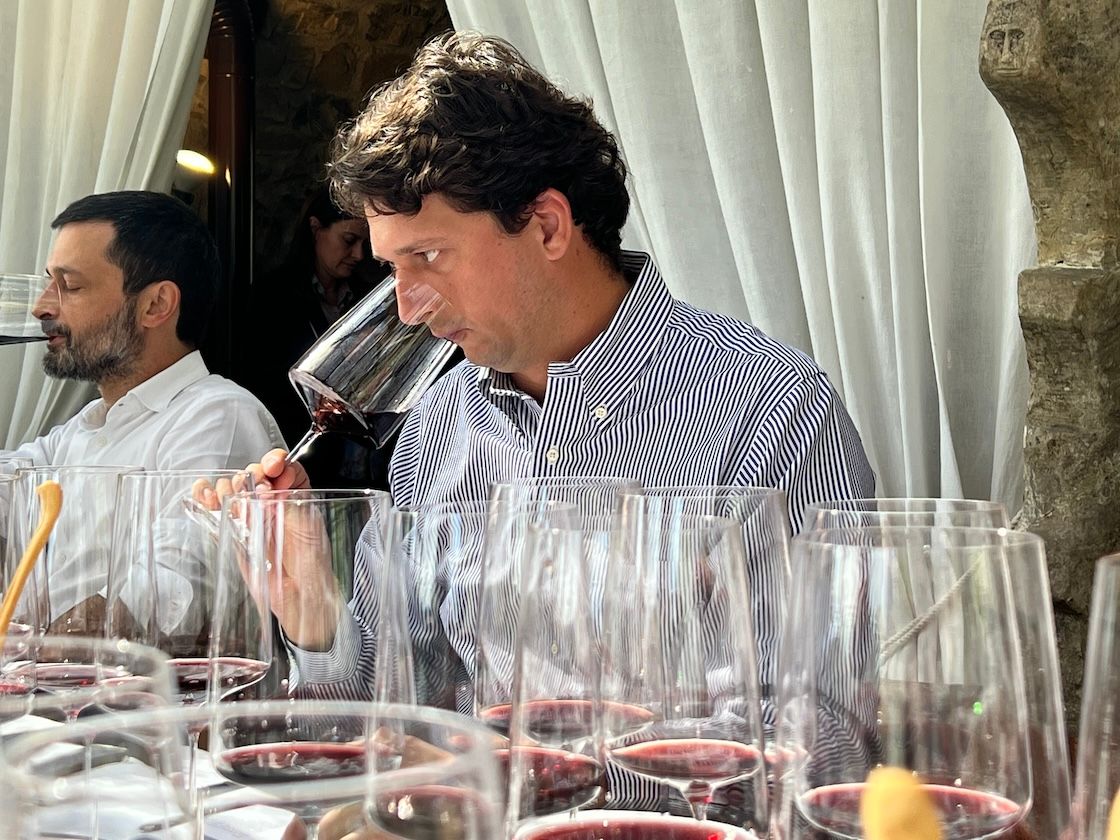James Suckling’s 99-point award for last week’s release of the latest vintage of Saffredi, the Bordeaux blend from Fattoria le Pupille was evidence yet again of how far these wines have progressed since Elisabetta Geppetti took on the estate in the 1980s. But it was also his observation that this is ‘the Lafite of the Maremma’ that struck a chord. Lafite? Surely no connection with Maremma? This, after all, was always the ‘underdog’ wine region of Tuscany little visited by tourists and renowned for making powerful, rustic, fruit-powered reds. Certainly not akin to a First Growth.
Suckling’s comments rang a bell and it was indeed in a review of Castello di Vicarello 2013 by Adrian van Velsen where he also described this particular Bordeaux blend as being “closer to Lafite than to Masseto.”
Two producers in the Maremma making wines comparable to one of the finest estates on the planet? Surely not. I had tasted a 21-vintage vertical of Saffredi a few years ago and can testify to its greatness but had only fleeting tastes of Castello di Vicarello.
A timely invite to travel to Tuscany to help celebrate 20 vintages of the estate's flagship wine, Castello di Vicarello, was quickly replied to in the affirmative and bags hastily packed.
One of the best in Tuscany...

Castello di Vicarello is a boutique wine estate, perched precipitously 350 metres up in a renovated borgo dating back to the 12th Century. Like all good Tuscan estates it has its own castle, converted into a luxury hotel, guests of which can indulge themselves in making pasta or leather goods, or simply bubbling the day away in the outdoor jacuzzi made from an old wine vat that overlooks whoop-out-loud scenery.
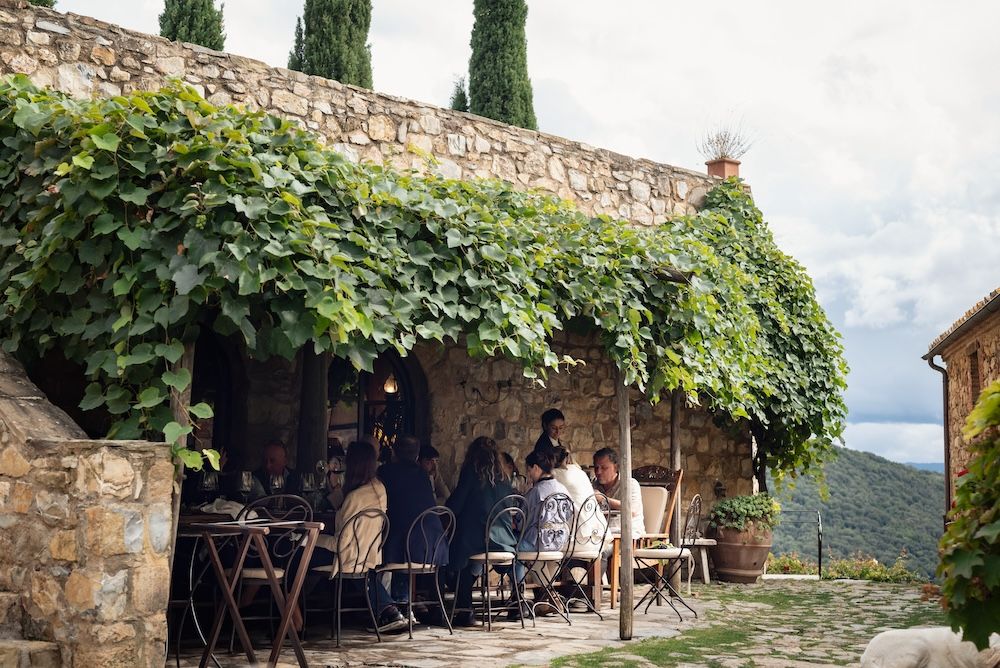
One of the outdoor dining areas of the castle
Conde Nast rates it as one of the best hotels in Tuscany (my suite cost a cool €3k a night), Mario Testino shot Lara Stone for Vogue here and Alex Turner from the Arctic Monkeys hired the joint for a party – described to me as his “wedding reception” but I could have misheard ;)
So far so chic but what of the wines?

Brando Baccheschi Berti and winemaking consultant Maurizio Saettini (l-r)
Like all good Italian estates ‘family’ and ‘history’ are also paramount. Owners Carlo and Aurora Baccheschi Berti lovingly restored the borgo and then, after a visit to Bordeaux with his son Brando, Carlo started planting Bordeaux varieties in 2000 and 2002, the first vintage of Castello di Vicarello being produced in 2004.
This inaugural Castello vineyard (on clay and limestone soil) is planted to 45% each of Cabernet Franc and Cabernet Sauvignon and 10% Petit Verdot, which is the exact proportion of the wine’s final blend, all the grapes harvested on the same day, field blend style.

The ancient alberello-trained vineyards in the original Castello vineyard
Also pure in concept was the unusual decision to adopt the ancient Tuscan alberello vine-training method where each vine forms an arch, protecting itself from the fierce Maremma winds. The vines are also planted to extremely high density from 9,000 to 13,000 vines per hectare, which forces the roots to go deeper, helping combat water stress and bringing complexity and texture to the resulting wines.
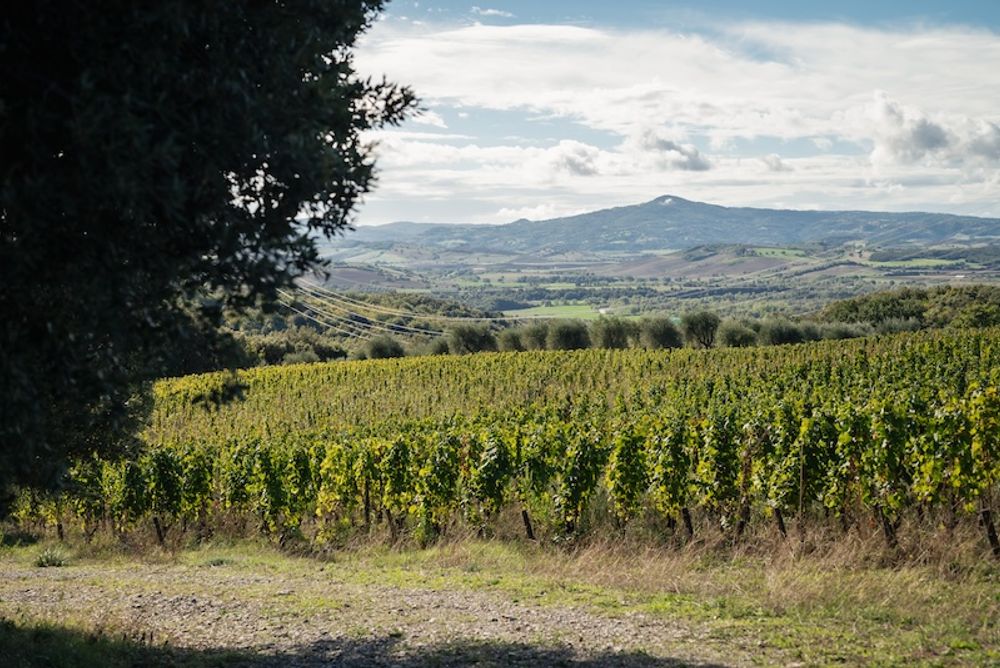
The Poggio Vico vineyard with Monte Amiata in the background and beyond that the Mediterranean
Since plating the 1.1 hecatare Castello vineyard, the team has planted two more vineyards – the 3.5-hectare Poggio Vico vineyard planted to Cabernet Franc, Malbec, and Merlot and the 1.5-hectare Vigna Anfiteatro, a bowl-shaped vineyard planted on terraces to Sangiovese and Merlot.
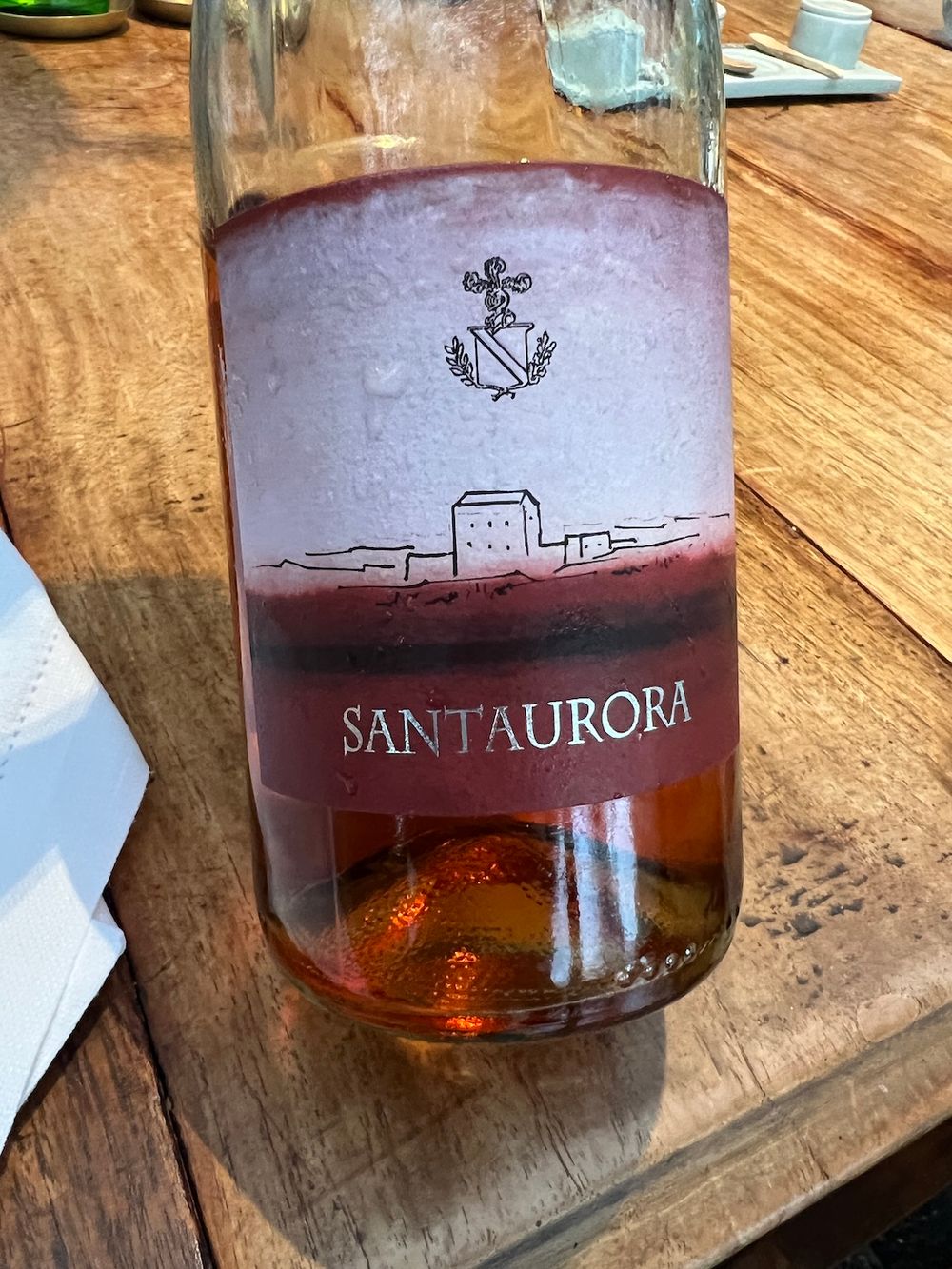
Although the focus of the visit was to analyse Castello di Vicarello the estate did show its other wines – ‘second wine’ Terre di Vico a SuperTuscan blend of 65% Sangiovese, 25% Merlot and 10% Cabernet Franc (6,500 bottles), Santaurora, a distinctive, gastronomic rosé made from 100% Malbec (1,500 bottles), Merah, a 100% Sangiovese (7,500 bottles) and Poggio Vico a 100% Malbec (2,500 bottles). Where Terri di Vico shared its 2004 debut with the ‘first’ wine, Meerah and Santaurora were introduced with the 2014 vintage and Poggio Vico in 2022 with the 2018 vintage.
All the wines are IGT with the winemaker being consultant Maurizio Saettini. The wines are made at off-site facilities although there are plans in the pipeline to change this with an on-site facility.
Getting to grips with Castello di Vicarello
Generally speaking, Castello di Vicarello is an impressive, premium Bordeaux blend that delivers an abundance of lush black fruit with layers of complexity, underpinned by considerable acidity that owes its presence to organic viticultural practices and the power of the soil.
Because of the field blend harvesting, there is massive vintage variation (as the tasting concluded) which is always a plus in my book as it means that following these wines is much more interesting than 'cookie cutter' wines.
In terms of the winemaking, the hand-picked grapes are sorted in the vineyard after harvest in the final third of September then, before and after de-stemming, the must goes into 30hl tapered vats of French oak for primary and malolactic fermentations. After one to two months of submerged-cap maceration the wine is then racked off the gross lees and matures sur lie for 20 to 24 months in French oak barrels of 160, 225, or 300 litres, followed by a further ageing in the bottle for a minimum of 24 months.
Putting 12 vintages of Castello di Vicarello to the test
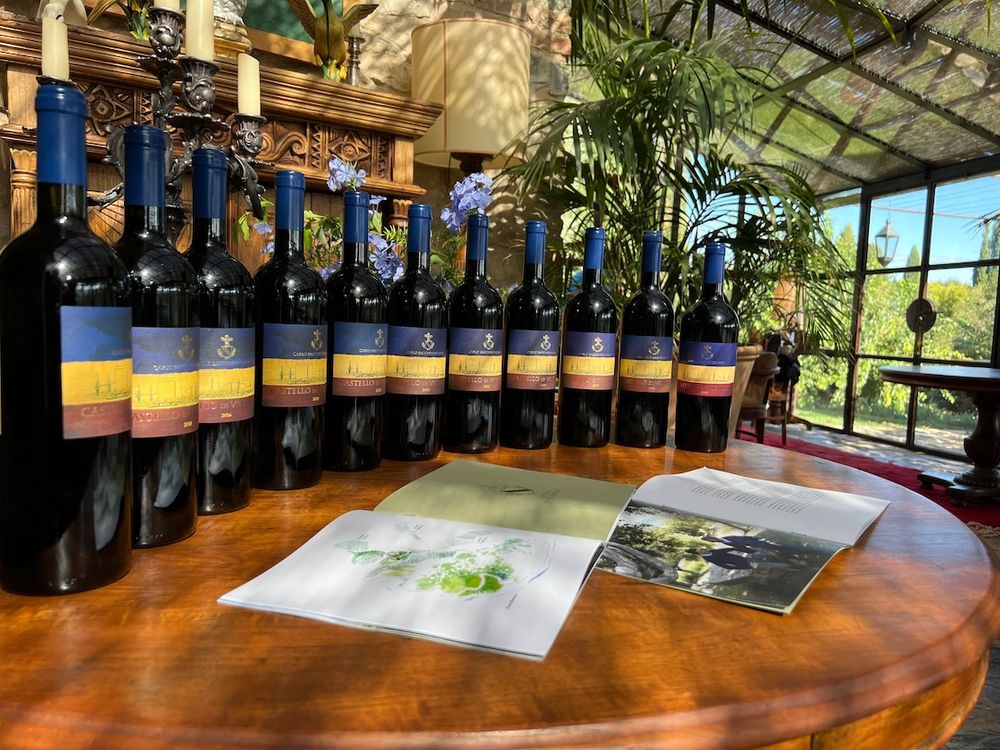
Twelve vintages of the wine were chosen from the 20 years the wine has been made.
Castello di Vicarello 2004, IGT Toscana
A well-balanced vintage – quite hot – which had textbook ripening of the fruit. For this first vintage and the 2005 the winery vinified with a tonneau that had an ‘arm’ inside. All barrels were 100% new.
To look at, the wine is cherry-blood red; complex nose, secondary to tertiary notes apparent – very savoury, fresh tan leather, prune, sun-dried tomatoes, macerated strawberries, hearth, earth, blood, lightened by a sweet floral note (pot pouri). In the mouth the wine is still fresh, medium weight, with the acidity of the Maremma soil powering through. Dry finish. Still drinking well but I wouldn’t cellar this for much longer. 13% abv.
Castello di Vicarello 2005, IGT Toscana
A cool start to the growing season, then near-drought conditions with warmth prior to harvest time and particularly warm nights. Yield lower than average.
To look at the wine is blood red with a reddish hue; lovely evolution on the nose – savoury aromas, the fruit is less sweet than the 2004, beef broth, black berries and a distinctive herbal note – dried oregano perhaps? On the palate the wine has a warm mouthfeel, reflecting the heat of the vintage. The tannins are ripe, powdery and fine; long length on the finish with great flavours, then more heat on the finish which suggests more alcohol than the actual 13% abv.
Castello di Vicarello 2006, IGT Toscana
A good growing season in the Maremma, marked by slightly higher-than-average but not excessive day and night-time temperatures. Rainfall was heavy in July and August. Overall, an impressive, balanced year, which produced supple wines with generous tannins and normal acidities.
Deep cherry red; the bouquet is a tad reserved, less bright than when I tasted this vintage three years ago; you detect mint and eucalyptus, blackberries; in the mouth the wine is medium-bodied, fine-grained, ripe tannins, a nice energy to the wine, driven by vibrant acidity keeping the mouth fresh and the wine well balanced. Secondary notes coming through on the palate – mi cuit tomatoes and lambs' blood, nicely evolved, drink now. 13% abv.

Brando Baccheschi Berti and Maurizio Saettini preparing the wines for the tasting
Castello di Vicarello 2007, IGT Toscana
Winter and spring saw above-average temperatures but little rainfall, followed by a cool, rainy June that brought vine-growth back into balance. July and August gifted fine weather, with cool nights that kept acids high and resulted in ripe phenolics and regular alcohol. A memorable vintage, with broad, deep wines with dense, ripe tannins, and an impressive acidic grip bolstering the firm structure.
Deep cherry-ruby red; the nose feels more evolved than the 2006; intense, concentrated and ripe, fig confiture, cocoa, damp underbrush. Rich and intense with bags of fruit but integrated and balanced by a sturdy framework of acidity. Touch of chalk/ cheesecloth on the finish. The bottle I tried in 2021 had a fault this, however, was showing well. 13% abv.
Castello di Vicarello 2009, IGT Toscana
A mild, rainy winter re-filled groundwater reserves. May was quite hot, boosting phenolic levels, but cool, rainy weather in June re-balanced vine development. Dry, hot weather returned in July and August and lasted until the first third of September, when a few rain spells assisted completion of the ripening cycle. The wines exhibit high alcohols and impressive volume.
To look at the wine is cherry red; aromas dominated by cassis and dark chocolate, nice degree of complexity with sweet tobacco, dark chocolate, fig, eucalyptus and a cheese note; In the mouth the wine is medium weight, fresh, open, welcoming you with open arms, nice fine grainy tannins, lovely balance with that keen acidity, blood orange zest and saltiness counterpointing with the dark chocolate notes on the finish. The wine feels relaxed and with sound balance, despite the high alcohol. Delicious. 14.5% abv.
Castello di Vicarello 2011, IGT Toscana
A challenging growing season where a mild, rainy winter was followed by an early spring and constant above-average temperatures, which returned in August with two heat waves mid-month. Harvest arrived early, and yields were low with the lack of rainfall negatively affecting crop quality. The wines are forceful and tannin-rich.
To look at the wine is medium ruby red; on the nose the wine feels like a very warm vintage, the wine is very evolved with stewed fruit, black cherries, rumptopf, marzipan and lamb’s blood; the Cabernet Franc is showing more with a pepper character. In the mouth the wine is muscular with huge depth, the fruit big and concentrated. Still got the acidity to allow it to age for longer, but tempting to drink now with a sliced, bloody steak. Got a Napa-ness to the nose but has this wonderful mineral-like acidity that is coming from the Maremma soil. A blockbuster for sure which will have its fans but, for my palate, it was one of the least successful in the line-up. 15% abv.
Castello di Vicarello 2012, IGT Toscana
2012 was one of the driest growing seasons on record here. A cold early Spring with snowfall contributed to refilling water reserves and facilitating a normal bud break but from the spring to September it did not rain at all. Those late rains and wide diurnal temperature range did usher in what the estate calls ‘at least satisfactory harvest’.
Cherry-red to look at the wine has a bouquet filled with red berries and ripe red cherries, there’s a nice bright floral note too. In the mouth the wine is fresh, with an open mouthfeel, great balance, lovely integration of the acidity, blood orange, so juicy! The finish is very dry with attractive flavours of mulberry, just-ripe blackberry, raspberry, orange zest, saltiness. Blue plum skin bite. Gastronomic. 14.5 % abv
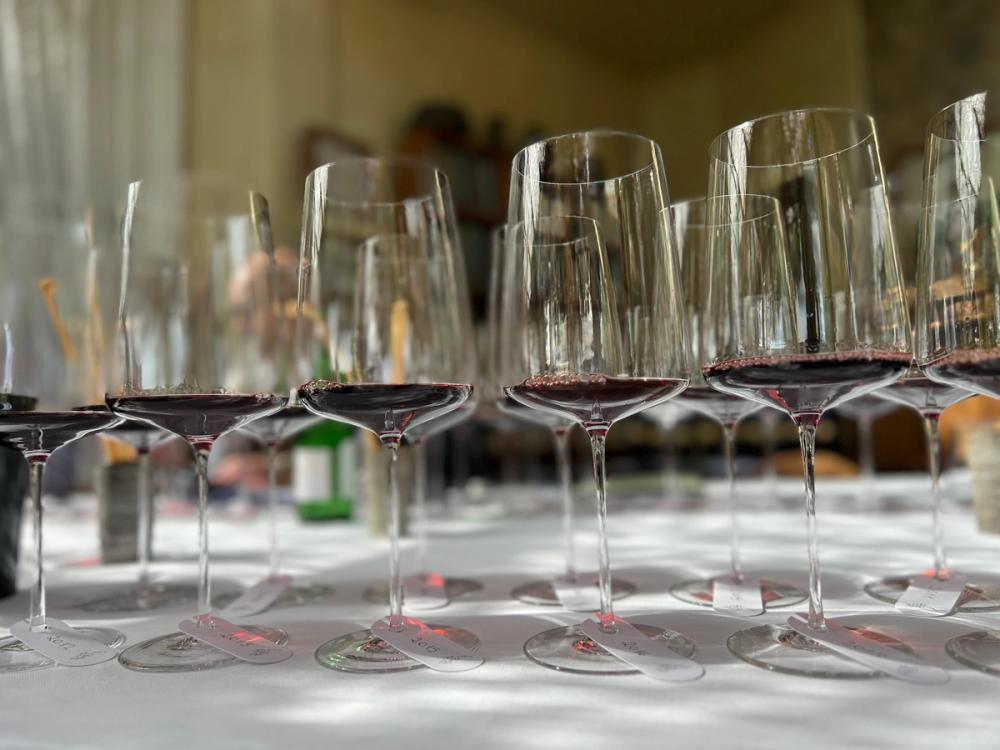
Castello di Vicarello 2013, IGT Toscana
The growing season was quite cooler than the two previous years. Rainfall marked both winter and early spring, but they were followed by a classic Mediterranean summer with days rarely above 30°C, cool, crisp nights, and summer rainstorms in August. September was cool, and easterly winds kept fungal attacks at bay. Ripeness levels were ideal in late October, and the harvest brought in fruit of phenomenal quality with thrilling acidity and tannins.
To look at the wine is light, red cherry/ruby; stunningly inviting nose, vivacious and elegant, lovely mix of red and black fruit – blackberries, strawberries – hint of bay leaf, charcoal; in the mouth the wine is medium weight, fabulous balance and integration, ripe and full of red and black fruit, red plum, sandalwood a hint of redcurrant, impressive structure with the concentration of the fruit beautifully framed by the acidity and fine, velvet tannins. Massive length. A stunner that is totally in synch with itself. Wine of the tasting and I totally agree with that review that said it had a 'Lafitte quality'. 14% abv
Castello di Vicarello 2015, IGT Toscana
Winter and spring were mild, with plenty of well-spaced rain, which built up groundwater reserves. Summer was hot and dry, with hot day-time temperatures, but water reserves allowed the vines to cope well, with the result that they yielded remarkably high-quality wines of impressive depth, with ripe, velvety tannins. The vintage’s considerable warmth was balanced by sturdy acidities.
To look at the wine is medium-bright ruby red; the nose has built some complexity since last tasting – sandalwood and leather join the black and red cherry, dried flowers with a hint of incense; in the mouth the wine is medium-full weight, beautifully fresh, juicy, the fine-grained, ripe, dry tannins are clearly more youthful. Rich, intense, structured, the various components feel less integrated with one another, but have great promise. 14% abv
Castello di Vicarello 2016, IGT Toscana
Considered one of the vintages of the century – the spring was wet, the summer sunny with no heat spikes and good day-night temperature variation. September had well-distributed precipitation with cool winds that allowed for perfect grape ripening.
Shy on the nose, which was unexpected given the growing season, sun-dried tomatoes, savoury, black cherries; In the mouth the wine is fresh as you like, elegant, with pixilated, powdery tannins to the fore, crisp blue berry fruit, lovely liveliness, more linear with a salty, blue plum finish. Impressive. 14% abv.
Castello di Vicarello 2018, IGT Toscana
Generally a good growing season with a very rainy spring that followed a mild and dry winter. The summer was hot but without massive heat spikes and relieved by light rain. The fruit reached good levels of maturity.
To look at the wine is deeper, more purple/red than 2016 or 2019. Much more floral on the nose with intense black fruit, blackberry Chewits, a hint of putty. Lovely fresh mouthfeel, juicy black fruit, mulberry, wild blackberry, touch of tomato leaf, nice balance – medium weight, has more breadth to the palate. Powdery dry but ripe tannins need more time in the bottle. Great promise. 14% abv
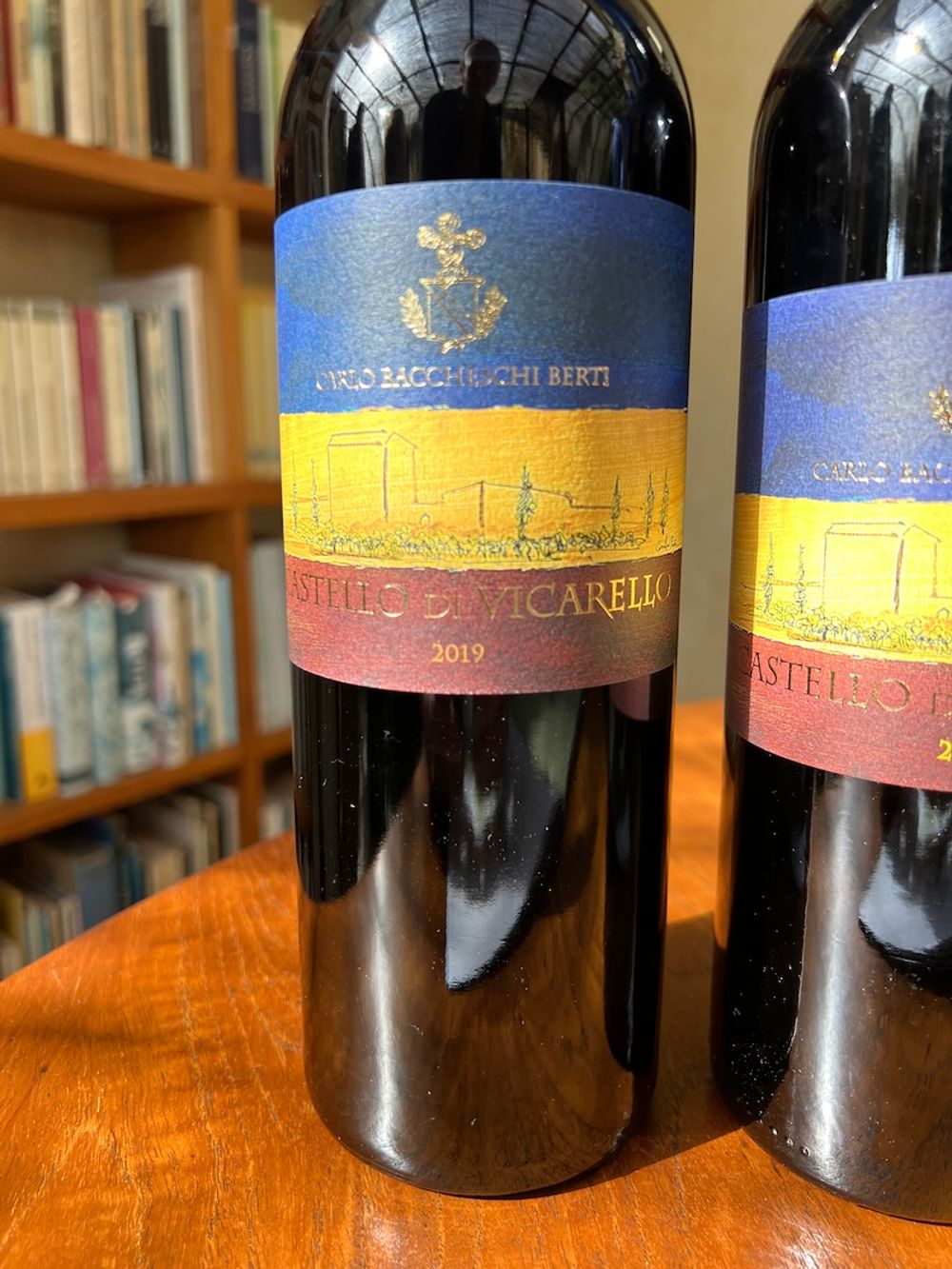
Castello di Vicarello 2019, IGT Toscana
A cool May was followed by a hot and dry June with summer months back to a Mediterranean norm. Good rainfall and low night-time temperatures meant that the ripening was slow but optimal, producing wines with intense aromas and early approachability.
The bouquet is marked by sun-dried herbs – rosemary, oregano – tomato leaf and sweet tobacco. In the mouth the wine is clearly youthful, almost petulant (!) with young, lovely, fine-boned, ripe, vibrant tannins. Ripe red and black fruit, a chalky minerality with fine spice and subtle herbs on the finish. Great liveliness to it. Will be fascinating to see how this ages. 14% abv. Released February-March 2025.

Assembled scribes for the Castello di Vicarello 20-vintage celebration
On the day and, in my opinion the wines that were showing best were 2013, 2007, 2016, 2015, 2009.
This is a winery that is clearly on the up and worth keeping a close eye on.
The wine is available in the UK through Fortyfive10.
